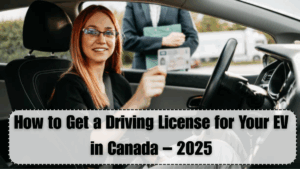For many Indian newcomers settling in Canada, owning or bringing an electric vehicle (EV) is an increasingly popular choice. However, the first step to getting behind the wheel legally is obtaining a valid driving license for EV owners under Canadian road laws. The licensing process is straightforward, but it involves specific steps—especially for immigrant driving applicants.
Whether you already hold a license from India or are starting fresh in Canada, this 2025 guide breaks down the complete process of acquiring a Canadian EV driving license. From knowledge tests to vehicle registration, this article ensures you’re fully prepared to drive your EV with confidence across provinces.

Step 1: Understanding the License Types for EV Owners
In Canada, there are two common license classes relevant to EVs:
-
G Class (Ontario) or equivalent: For standard cars, including electric vehicles
-
Class 5 (in British Columbia, Alberta, etc.): Also valid for EVs
New EV owners must meet the same road rules and testing requirements as traditional vehicle owners. However, if you’re planning to drive an automatic EV (most common), then the license will be marked for automatic transmission only. Understanding this helps EV rules compliance when registering or insuring your car.
If you’ve recently arrived in Canada, your immigrant driving history can impact the process—especially if you carry a valid Indian license.
Step 2: License Exchange and Eligibility for Immigrants
Canada allows certain license exchanges depending on your country of origin. Unfortunately, India is not on the direct exchange list, which means most Indian EV owners must go through the full process: written test, vision test, and road tests (G1, G2, and G).
However, immigrants with over 2 years of documented driving experience in India can sometimes skip the waiting period between G1 and G2 levels by showing:
-
Original Indian driver’s license
-
Proof of experience (like a driving abstract from RTO)
-
Translated documents (English or French only)
This makes the journey toward a driving license for EV owners easier for long-time drivers.
Step 3: Written Test, Vision Test & G1 Permit
To begin your immigrant driving journey, you’ll need to pass the G1 (learner’s permit) test, which includes:
-
Traffic laws and EV rules
-
Road signs and safe driving practices
-
Basic vehicle maintenance knowledge (especially for EVs)
Some provinces like British Columbia may also include questions about charging stations, EV battery awareness, and eco-friendly practices. This ensures new EV drivers understand both the license Canada law and environmental expectations.
Once you pass the written and vision test, you will receive your G1 permit or Class 7 learner’s license.
Step 4: Road Tests and Getting Your Full License
After practicing for a few months (or immediately if you’re eligible), you can book your G2 and G road tests. The final road test checks your ability to drive in real traffic conditions, use of mirrors, speed control, and EV-specific behaviors like smooth braking and battery conservation.
Once completed, you’ll receive your full driving license for EV owners, allowing you to drive legally across all provinces. This also unlocks your ability to insure your car and take advantage of federal and provincial EV rebates.
Summary Table – Driving License for EV Owners in Canada
| Step | Description |
|---|---|
| G1 Written Test | Required for new applicants (includes EV rules and signs) |
| License Exchange | Not available for Indian licenses; full test process required |
| Driving Experience Proof | RTO extract or experience letter may reduce waiting period |
| Road Tests | G2 and G level driving assessment for all EV owners |
| Final License | Issued by province; marked for automatic if using EV |
FAQs
Do I need a different license for EVs in Canada?
No, the driving license for EV owners is the same as for traditional vehicles. However, you may be marked for automatic transmission if you drive only EVs.
Can Indian immigrants exchange their license in Canada?
No. Indian licenses are not eligible for direct exchange. Immigrant driving applicants must take all required tests.
What are EV-specific rules in Canadian driving tests?
EV rules include awareness about charging safety, battery levels, regenerative braking, and efficient driving habits during road tests.
Can I apply for a license with just my Indian DL?
You can use it as proof of experience, but you must still go through written and road tests to get your license Canada credentials.
How long does the full process take for newcomers?
It depends on your driving experience. With documents, some can get a driving license for EV owners within 3–6 months. Without, the process may take up to a year.
Click here to know more.
